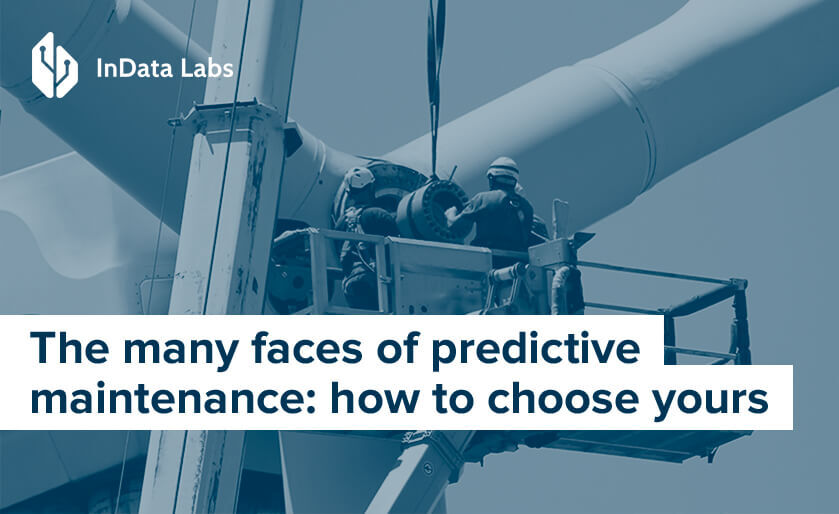Machine failure prediction using machine learning can enhance operational dependability, making the fundamental purposes of predictive maintenance and the usefulness of incorporating machine learning into collapse forecasting come true. ML specialists can also examine the most influential algorithms shaping workflow efficiency.
This article explores data analytics and predictive modeling to study a new technique that allows companies to foreknow and avert machine breaks. Join us in exploring the latest progress in maintenance practices.
What is machine learning failure predictive maintenance?
Utilizing machine learning for equipment failure prediction is an innovative strategy employing AI software. It analyzes data through predictive modeling to estimate equipment conditions, pinpointing the optimal time for maintenance. Industries dependent on intricate supplies find these solutions crucial.
Powered by AI software, predictive maintenance enhances the dependability and performance of equipment by handling probable troubles before they escalate into failure or collapse.
Predictive maintenance’s main goals

- Lowering expenses is another important objective, and one way to achieve this is by cutting down on maintenance expenditures. Predictive maintenance can accomplish it by facilitating prompt repairs and controlling failures, ultimately decreasing total operating charges by bypassing costly repairs.
- Predictive maintenance involves various actions to meet the objectives of scheduled repair and prevention. One significant step is establishing a baseline for equipment workload over time. This data is then utilized to study the present workflow and determine conceivable troubles.
- System setup. Predictive maintenance entails setting up a real-time system that tracks equipment’s operational status. To react quickly to deviations or malfunctions, its state must be continually checked, as this assures.
With these measures, the companies hope to lower expenditures, raise supply dependability, and preserve resources by developing an effective maintenance plan.
How machine failure prediction improves systems
Failure prediction machine learning software delivers many advantages across various industries. Here are the fundamental benefits:
Efficient prices
Employing predictive maintenance qualifies companies to administer resources more efficiently. Optimizing resource utilization can be achieved by anticipating failures and evading expensive repairs. Take a moment to watch a video and learn the key benefits of machine failure prediction with ML:
Preventative maintenance reduces operational expenses by minimizing the necessity for immediate repairs, resulting in substantial monetary savings. This approach helps to minimize unforeseen payments and enhances budget management overall.
Security increased
Incorporating machine learning techniques into safety measures allows systems to function as prematurely cautioning systems for noticing potentially hazardous situations. Utilizing machine learning models to forecast server failures ensures a more secure working environment.
Prevention units are designed to reduce the chances of accidents and initiate preventive measures. Proactive safety measures contribute to creating a safer workplace by minimizing potential hazards.
Higher efficacy of operations
Operations run more smoothly with fewer interruptions. This leads to increased output and operational effectiveness. Prompt maintenance and repairs remove bottlenecks and improve overall effectiveness. Optimized procedures facilitate an efficient and productive workflow.
Scalability
Machine learning facilitates scalability by improving general performance. As businesses expand, machine learning assists in identifying and addressing probable difficulties, ensuring growth without compromising performance.
Enhanced client satisfaction
Swift identification and repair of equipment issues lead to rapid resolution, minimizing customer inconvenience. Quick repairs lead to a positive customer experience.
Predictive maintenance ensures a consistent and reliable service, increasing client satisfaction and fostering loyalty. Reliable services enhance the general customer experience.
Human resource optimization
Machine learning technologies accessible human resources from routine tasks, allowing them to focus on more involved and influential work. Such optimization enhances employee job fulfillment. As machine learning systems handle repetitive tasks, employees can develop and utilize more advanced skills. This fosters professional growth and ensures a skilled workforce.

Source: Unsplash
Drug development through AI advancements
In pharmacology, the integration of machine learning is transforming the landscape of drug development. By optimizing experiments and foreseeing outcomes, AI accelerates the pace of research, fostering rapid advancements in medical treatments.
The marriage of machine learning and pharmacology accelerates and streamlines pharmaceutical research. This synergy propels innovative medical treatments to the forefront, marking a pivotal point in the evolution of healthcare. The remarkable efficiency achieved through AI in drug development is reshaping the hereafter of medical science.
Tailored predictive models
Leveraging machine learning empowers the invention of customized predictive models that cater to specific industry needs. This flexibility ensures precise and personalized prognoses tailored to the unique needs of diverse sectors.
Evidence-based decision-making
The predictive analytics implementation with ML yields invaluable insights and facilitates evidence-based decision-making. This guarantees businesses and industries adopt well-informed strategies grounded in comprehensive data examination.
The incorporation of ML in failure prediction is a cutting-edge new machine learning techniques, revolutionizing how businesses come with maintenance, safety, and efficiency. This innovation represents a powerful stride in enhancing operational resilience and optimization across various industries.

Source: Unsplash
Application of machine learning-based failure prediction in various industries
Machine learning-based failure prediction has been verified to be a helpful tool in multiple business domains. It has enhanced maintenance and functional efficiency for enterprises by enabling them to envision equipment failures, distribute resources efficiently, and ensure seamless processes. Now, we will examine the wide-ranging applications of machine failure prediction in various industries, highlighting the substantial influence of this technology.
Manufacturing optimization via machine learning
In manufacturing, using machine learning to indicate server failure emerges as a critical strategy for maintaining a seamless production flow. Manufacturers can proactively recognize probable failures by examining historical data and real-time equipment monitoring, allowing for timely scheduled maintenance. This farseeing practice minimizes downtime, eliminates production bottlenecks, and elevates operational efficiency.

Source: Unsplash
Elevating transportation and logistics efficiency
Vehicles and machinery’s continuous and reliable function is paramount within transportation and logistics. The ability to indicate machine failures becomes imperative in guaranteeing fleet trustworthiness, providing real-time insights into vehicle conditions. This technological advancement proves instrumental in optimizing maintenance plans, improving fuel efficiency, and boosting all-around fleet productivity, leading to substantial cost redemptions and safer operational patterns.
Machine learning in healthcare
Integrating machine learning in healthcare to forecast machine failures holds immense prospects for transformative advantages in this domain. Predictive analytics is vital for optimizing healthcare processes, increasing efficiency, and enhancing patient outcomes. The utilization of machine learning in healthcare not only predicts machine failures but also contributes to creating a more valuable and seamless healthcare environment by optimizing resource issuance.
Pharmacology
Machine learning is impacting equipment failure prediction in pharmaceutical enterprises. Predictive analytics in pharma is crucial for drug development, optimizing experiments, and forecasting outputs. AI in pharma simplifies pharmaceutical research, accelerates the investigation pipeline, and enhances therapies. The blend of machine learning and pharmacology holds great potential for innovation in healthcare.

Source: Unsplash
Energy and utilities
The energy and utilities sector needs to anticipate supply failures. Machinery and equipment are necessary for generating and distributing electricity. Machine learning algorithms can forecast turbines, generators, and other crucial parts collapses. Taking proactive measures in maintenance enhances dependability, minimizes unexpected downtime, and guarantees a steady and adequate energy provision.
Aerospace and defense
The aerospace and defense industry uses complex machinery and systems that follow strict reliability standards. Machine learning-based failure prediction improves predictive maintenance for aircraft, spacecraft, and defense gear. This cutting-edge technology ensures the safety and dependability of aerospace operations, ultimately contributing to mission success and equipment longevity.

Predicting equipment failure using a machine learning algorithm
Developing a predictive analytics model for machine failure encompasses several vital stages. Let’s dissect each phase to understand the entire process comprehensively.
Data loading
Initiating the process involves collecting essential data. This includes importing relevant libraries and loading the dataset. It is paramount to identify the target variable, which, in this context, signifies instances of machine failures. Accurate loading of data ensures that prognoses align with real-world scenarios.
Data cleaning
The second stage involves scrutinizing the data for missing values. A visual representation, such as a barplot, aids in identifying columns with missing values, guiding the cleaning process. Ensuring the dataset is free from outliers or incomplete entries is pivotal for precise predictions.
Data exploration
The third phase delves deeply into the dataset to unveil patterns and trends. Visual tools like graphs and charts are employed to comprehend relationships and pinpoint clusters of similar elements. Devoting time to explore datasets is essential for extracting insights that might be overlooked in a hurried examination.
Data preparation
Data preparation is critical for machine learning. The data_preparation function is vital in encoding categorical variables and partitioning the dataset into training and test sets. This ensures the model is trained on well-organized, clean data, mitigating overfitting and enriching interpretability for machine learning algorithms.

Source: Unsplash
Model training
In the subsequent step, model training implicates constructing a robust model using methods like boosting. This phase is vital for achieving accurate predictions. The adaptability of these methods allows for fine-tuning to optimize results, making them practical choices for various classification tasks.
Model evaluation
The final step involves assessing the model’s performance through scoring, cross-validation, and a confusion matrix. Scoring gauges prediction accuracy utilizing metrics like accuracy and f-measure. Cross-validation tests the model with different parameters to determine the optimal configuration. The confusion matrix visually illustrates the model’s performance, pinpointing modification areas.
The most used predictive modeling techniques
Three of the most commonly utilized machine learning algorithms for failure prediction are examined below:
Decision trees
Decision trees function as a supervised algorithm for both classification and regression tasks. This method involves constructing a tree-like graph or model that delineates decisions and their potential outcomes, considering factors like chance events, resource costs, and utility. The main benefit of decision trees is their ability to pinpoint the most crucial features in a dataset, offering insights into how variations in these features influence the overall model outcome.
Random forests
Random forests adopt an ensemble learning technique by amalgamating multiple decision trees into a unified prediction model. This approach evaluates the output from each decision tree and classifies new examples based on the tree that provides the most accurate prediction. The strength of random forests lies in their capacity to mitigate overfitting by employing multiple decision trees with different parameters. This ensemble approach enhances accuracy, surpassing what a single decision tree could achieve independently.
Support vector machines (SVMs)
SVMs are supervised machine learning algorithms predominantly utilized for classification and regression tasks. Operating through the creation of a hyperplane, SVMs segregate data points into distinct classes, facilitating the prediction of unknown data points based on their classification within the hyperplane boundaries. SVMs excel in scenarios involving datasets with numerous features, adeptly capturing intricate relationships between variables. SVMs effectively separate data points into different classes by identifying optimal hyperplanes in high-dimensional space.
To choose the most suitable technique, you can turn to AI consulting services to get a professional view of your business needs and procedures.
Conclusion
Machine failure prediction using machine learning has the potential to be an invaluable tool for any business that regularly uses and maintains machinery. By leveraging predictive analytics, companies can proactively identify and take care of possible losses before they occur, decreasing costly downtime.
Furthermore, this technology can help inform decisions regarding when to replace or upgrade equipment, ensuring maximum efficiency and cost savings. With continued improvements in machine learning, businesses can unlock the maximum potential of this technology and use it to improve the dependability of their systems.
Author bio
Yuliya Melnik is a technical writer. She is passionate about innovative technologies that make the world a better place and loves creating content that evokes vivid emotions.



